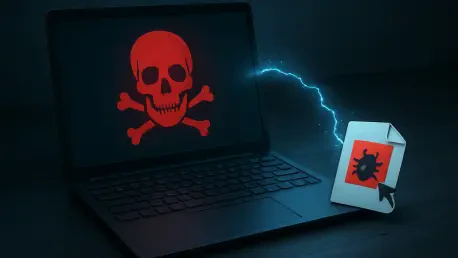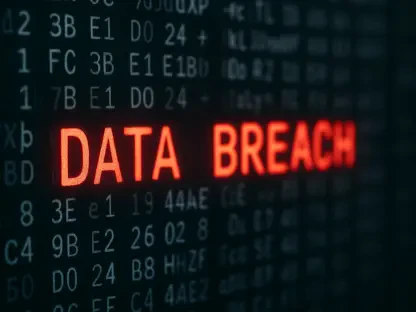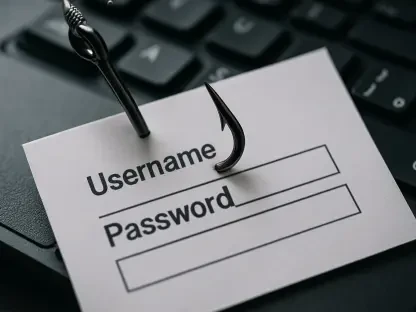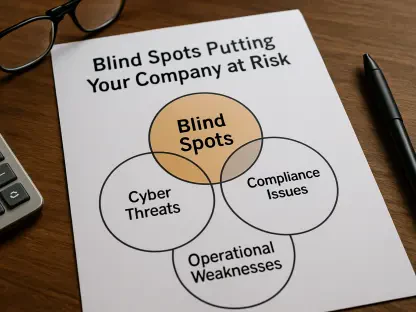In today’s digital landscape, where trust in routine file exchanges can be a vulnerability, a staggering number of cyber incidents stem from seemingly innocuous documents, highlighting a critical security concern. Consider the scenario of a high-ranking executive receiving an urgent email with a ZIP archive labeled as a critical payment record or passport scan. Unwittingly clicking on what appears to be a harmless shortcut file inside, they unleash a sophisticated attack. This is the reality of malicious shortcut attacks, a cybersecurity campaign leveraging Windows shortcut (.lnk) files to deliver destructive DLL implants. Such threats exploit human trust through cunning social engineering, posing a significant risk to corporate environments, especially for those in management roles.
Unpacking the Threat of Shortcut-Based Attacks
The Art of Deception in Initial Engagement
At the heart of this campaign lies a calculated use of credential-themed lures designed to mimic legitimate documents. These ZIP archives often contain files masquerading as certified records, such as invoices or identity proofs, crafted to appear urgent and authentic. The deception preys on the inherent trust users place in familiar file types and routine business processes, making it a potent entry point for attackers.
Particularly striking is how these lures are tailored to specific behaviors in management and executive roles. Attackers exploit the urgency associated with tasks like payment approvals or identity verification, increasing the likelihood that a busy professional might overlook subtle warning signs. This targeted approach underscores the importance of understanding user psychology in modern cyber threats.
Stealthy Execution Through Malicious Shortcuts
Once a user interacts with the malicious shortcut within the ZIP archive, the attack unfolds with chilling precision. Clicking the .lnk file triggers an obfuscated PowerShell script that operates under the radar, using techniques like quiet flags to suppress visible windows or prompts. Additional measures, such as clearing the console and muting progress messages, ensure that the malicious activity remains hidden from the untrained eye.
This stealthy execution phase is a testament to the attackers’ focus on evasion. By minimizing any outward signs of interference, the script creates a seamless user experience while quietly setting the stage for more damaging actions. Such tactics challenge even vigilant users to detect anomalies in real time.
Payload Deployment and System Exploitation
The next phase involves the covert download of a payload, often disguised as a benign .ppt file to avoid suspicion. Once retrieved, this file is saved locally as a randomly named DLL, a move designed to evade filename-based detection. The attack then leverages the legitimate Windows utility rundll32.exe to execute the DLL, blending malicious behavior with normal system operations.
This “living-off-the-land” strategy is particularly insidious, as it uses trusted system binaries to mask nefarious intent. By embedding malicious actions within routine processes, attackers reduce the chances of triggering alarms in standard security tools. This approach highlights a growing trend of exploiting built-in system functionalities for illicit purposes.
Evolving Tactics in Evasion and Flexibility
Prioritizing Reliability Over Complexity
A notable characteristic of this campaign is the emphasis on operational reliability rather than intricate cryptographic techniques. Attackers opt for practical evasion methods that ensure consistent success across varied environments. This pragmatic mindset reveals a shift in cybercriminal strategy, focusing on what works effectively rather than over-engineering solutions.
Another layer of sophistication comes from the campaign’s adaptability to defensive measures. By actively checking for the presence of antivirus processes, the attack selects different payload variants tailored to bypass specific protections. Such dynamic responses to security landscapes demonstrate a keen awareness of detection mechanisms.
Obfuscation Through Innovative Coding
Further complicating detection efforts is the use of byte arrays to construct commands, avoiding clear-text indicators that might raise red flags. Traditional security tools often rely on recognizable strings like “rundll32.exe” to identify threats, but this method obscures intent and blends seamlessly with legitimate code. This technique represents a subtle yet effective barrier to conventional scanning approaches.
The cumulative effect of these evasion tactics is a significantly reduced digital footprint. By prioritizing stealth and adaptability, attackers maintain a low profile, making it challenging for even advanced security systems to pinpoint malicious activity. This evolving landscape demands equally innovative countermeasures.
Impact on Corporate Ecosystems
Targeting High-Value Workflows
The deliberate focus on executive workflows, such as payment validations and identity checks, maximizes the potential impact of these attacks. Management personnel, often under pressure to act swiftly, become prime targets for social engineering ploys that exploit urgency and authority. This strategic targeting amplifies the risk of breaches in critical decision-making chains.
Industries heavily reliant on document sharing and approval processes face heightened exposure to such threats. Corporate environments, where trust in digital correspondence is paramount, are particularly vulnerable to disruptions caused by compromised files. The ripple effects of a single successful attack can undermine operational integrity across departments.
Consequences of Breaches
When these attacks succeed, the fallout can be severe, ranging from data theft to substantial financial losses. Sensitive information, once extracted, may be used for further extortion or sold on illicit markets, compounding the damage. Financial repercussions, including direct losses and recovery costs, place additional strain on affected organizations.
Beyond tangible losses, the erosion of trust in internal systems and processes can have lasting effects. Employees and stakeholders may hesitate to engage with digital workflows, slowing down operations and necessitating extensive retraining. This broader impact illustrates the multifaceted harm inflicted by shortcut-based attacks.
Detection Hurdles and Limitations
Challenges in Identifying Stealthy Threats
Detecting these attacks poses significant technical challenges due to their reliance on legitimate Windows processes. The use of trusted binaries like rundll32.exe allows malicious actions to blend into routine system behavior, evading many traditional security checks. This integration with normal operations complicates efforts to isolate harmful activity.
Obfuscated scripts further exacerbate detection difficulties by hiding their true purpose. Security tools that depend on pattern matching or signature-based identification struggle to flag these threats, as they lack clear indicators of malice. The result is a detection gap that attackers exploit with alarming consistency.
Shortcomings of Conventional Defenses
Traditional antivirus software often falls short when payloads are disguised as benign files or executed through signed binaries. These protective measures, while effective against known threats, struggle to adapt to the nuanced tactics employed in shortcut attacks. This limitation underscores the need for more dynamic security solutions.
Ongoing efforts to enhance detection capabilities are underway, yet the pace of innovation among attackers often outstrips defensive advancements. Addressing these gaps requires a shift toward layered defenses that combine multiple approaches to threat identification. Without such evolution, organizations remain at a disadvantage.
Strategies for Mitigation and Defense
Practical Steps to Thwart Attacks
To counter these sophisticated threats, several actionable mitigations have been proposed. Blocking or sandboxing LNK files within archives can prevent initial execution, while enforcing the Mark of the Web ensures that downloaded content is flagged as potentially unsafe. Restricting the usage of rundll32.exe further limits the avenues available for payload deployment.
Enhancing system policies through tools like Windows Defender Application Control or AppLocker can deny execution from user-writable paths, a common tactic in these attacks. Additionally, robust PowerShell monitoring via script block logging, transcription, and integration with Antimalware Scan Interface (AMSI) provides deeper visibility into script-based activities. These measures collectively strengthen system resilience.
Proactive Measures and User Awareness
Beyond technical safeguards, hardening web egress with Transport Layer Security (TLS) inspection is critical to prevent malicious downloads at the network level. This approach ensures that payloads disguised as legitimate files are intercepted before reaching end users. Such proactive steps are essential in a threat landscape where prevention is often more effective than reaction.
Equally important is fostering user awareness to combat social engineering tactics. Training programs that educate staff on recognizing suspicious lures and understanding the risks of unverified files can significantly reduce interaction with malicious content. Empowering users to act as the first line of defense complements technical protections.
Reflecting on the Path Forward
Looking back, the exploration of malicious shortcut attacks revealed a cunning blend of social engineering and technical evasion that challenged conventional cybersecurity approaches. The campaign’s focus on exploiting trust and leveraging legitimate system tools underscored a persistent vulnerability in digital ecosystems. It became evident that traditional defenses struggled to keep pace with such adaptive threats.
Moving forward, organizations must prioritize the adoption of layered security strategies that address both technical and human factors. Investing in behavioral analysis and machine learning to detect anomalous activities offers a promising avenue for staying ahead of evolving tactics. Starting from this year through to 2027, a concerted effort to enhance monitoring and user education will be crucial in mitigating risks.
Ultimately, the battle against shortcut-based attacks demands a commitment to innovation and vigilance. By integrating advanced detection mechanisms with robust training initiatives, businesses can build a more resilient posture against deception-driven threats. The focus must remain on anticipating attacker ingenuity while fortifying the weakest links in the security chain.









